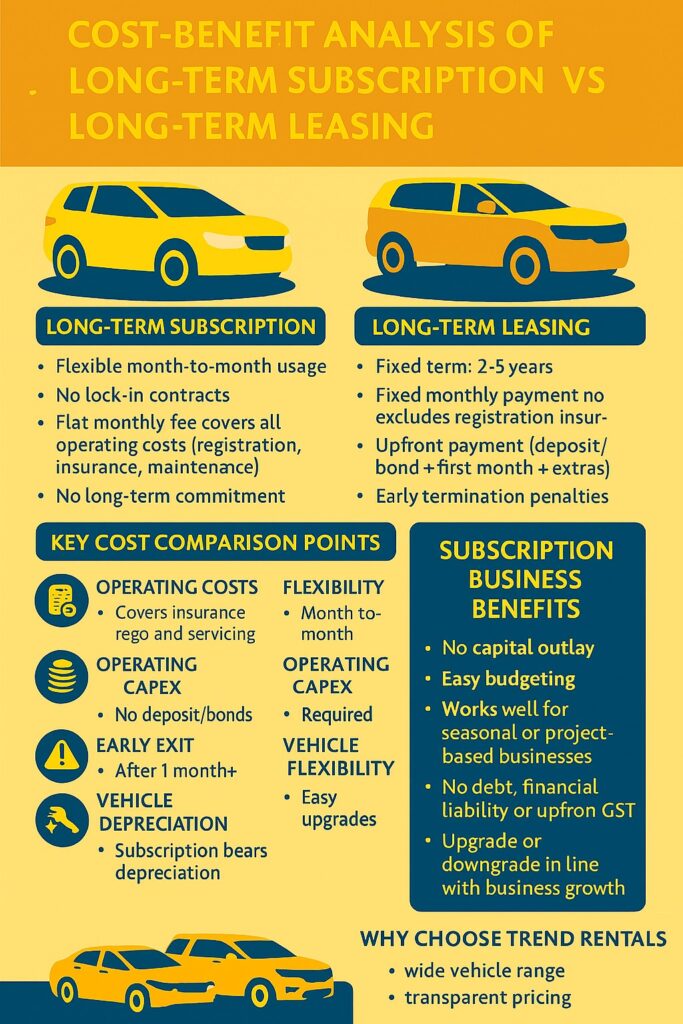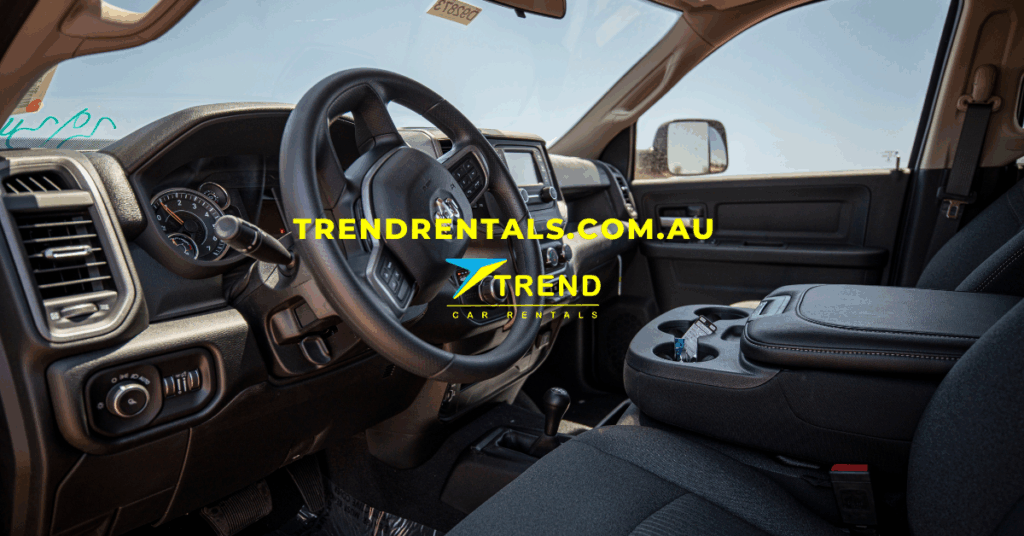Introduction
In today’s fast-changing mobility landscape, businesses and individuals are rethinking how they access vehicles. Traditional long-term leasing has long been the go-to option for those who don’t want to purchase outright. But the rise of long-term car subscription services is challenging that model, offering flexibility, transparency, and all-inclusive pricing.
At Trend Rentals, we’ve seen first-hand how subscription is reshaping fleet management, personal mobility, and even mining and resource sector transport. This blog provides a comprehensive cost-benefit analysis of long-term subscription versus long-term leasing, helping you decide which model best suits your needs.

What is Long-Term Subscription?
A car subscription is like a streaming service for vehicles. Instead of buying or leasing, you pay a flat monthly fee that includes:
- Vehicle use
- Registration
- Insurance
- Servicing & maintenance
- Roadside assistance
👉 Learn more about Trend Rentals Car Subscription.
Subscriptions are typically month-to-month or extendable, with no lock-in contracts. This makes them ideal for businesses with fluctuating needs or individuals who want flexibility.

What is Long-Term Leasing?
Leasing is a fixed-term contract, usually 2–5 years, where you pay a monthly fee to use a vehicle. Unlike subscription, leasing often requires:
- Upfront costs (deposit, bond, first month’s payment)
- Exclusions (insurance, registration, maintenance often extra)
- Early termination penalties if you exit before the contract ends
Leasing can be cost-effective for stable, predictable use cases, but it lacks flexibility.

Cost Comparison: Subscription vs Leasing
| Feature | Subscription | Leasing |
|---|---|---|
| Upfront Costs | None | Deposit + fees |
| Monthly Payment | All-inclusive | Vehicle only (extras separate) |
| Insurance & Rego | Included | Usually excluded |
| Maintenance | Included | Often excluded |
| Flexibility | Month-to-month | 2–5 years |
| Early Exit | No penalties after 1 month | High penalties |
| Vehicle Upgrades | Easy | Locked in |
| Depreciation Risk | Provider absorbs | Lessee bears risk |
| Tax Benefits | Operating expense | Lease liability on books |
👉 Compare flexible options at Trend Rentals Leasing vs Subscription.
Subscription Benefits for Businesses
- No Capital Outlay – Free up cash flow for operations.
- Easy Budgeting – One predictable monthly fee.
- Scalable Fleets – Add or reduce vehicles as projects change.
- No Depreciation Risk – Trend Rentals absorbs vehicle value loss.
- Short-Term Projects – Perfect for mining, construction, or seasonal industries.
See how subscription supports mine spec vehicle hire for project-based work.
Leasing Benefits for Businesses
- Lower Monthly Cost – Base payments can be cheaper than subscription.
- Tax Deductions – Lease payments may be deductible.
- Predictability – Fixed term, fixed vehicle.
- Ownership Option – Some leases allow buyout at end of term.
Subscription Benefits for Individuals
- No Credit Checks – Approval based on ability to pay.
- All-Inclusive – Insurance, rego, servicing included.
- Flexibility – Upgrade or downgrade as life changes.
- No Long-Term Debt – Avoid loans and finance contracts.
👉 Perfect for first-time drivers or those with poor credit.
Leasing Benefits for Individuals
- Lower Monthly Payments – If you can commit long-term.
- New Car Access – Drive a new car every few years.
- Ownership Option – Buy the car at lease end.
Total Cost of Ownership (TCO)
When comparing subscription vs leasing, TCO is critical.
- Subscription: Higher monthly fee, but covers everything. No surprise bills.
- Leasing: Lower monthly fee, but add insurance, rego, servicing, tyres, roadside, and depreciation risk.
For many, subscription ends up cheaper once hidden costs are factored in.
Flexibility and Risk
- Subscription: Cancel anytime after 1 month. No penalties.
- Leasing: Locked in for years. Early exit fees can be thousands.
Depreciation and Resale
- Subscription: Provider absorbs depreciation.
- Leasing: You may face residual value risk if market shifts.
Tax and Accounting
- Subscription: Treated as an operating expense. Off balance sheet.
- Leasing: May appear as liability. Complex accounting.
Case Study: Mining Company in Adelaide
A mining contractor needed 20 vehicles for an 18-month project. Leasing required a 3-year minimum, with high exit penalties. Subscription from Trend Rentals allowed them to scale up and down monthly, saving over $150,000 in unused lease payments.
Case Study: Small Business Owner
A tradesman with poor credit couldn’t secure a lease. Subscription gave him access to a ute with insurance included, helping him grow his business without debt.
Long-Term Outlook
Subscription is growing rapidly worldwide, especially in industries with seasonal demand. Leasing remains viable for stable, predictable needs.
Conclusion
Both models have merit, but for businesses and individuals seeking flexibility, transparency, and reduced risk, subscription is often the smarter choice. Leasing suits those with predictable, long-term needs and strong credit.
👉 Explore your options with Trend Rentals Subscription Services.